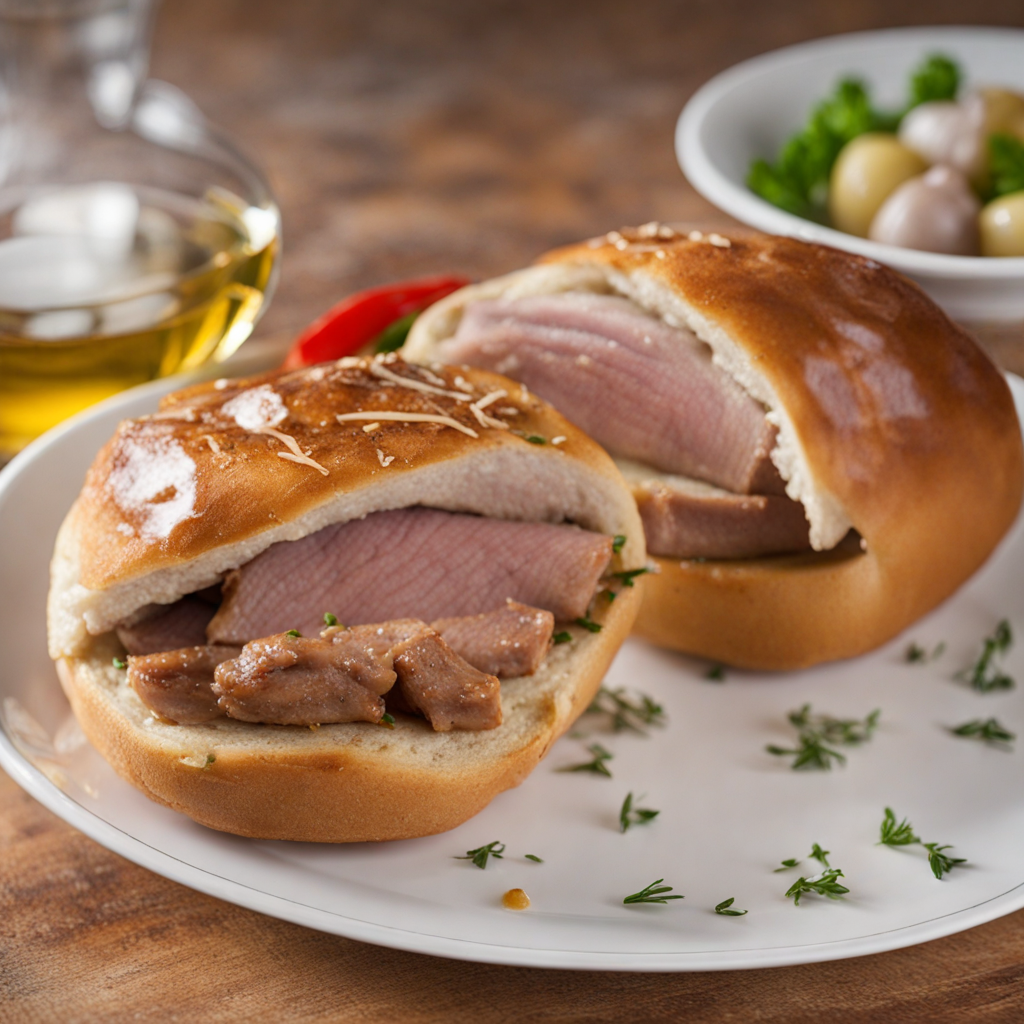Bifana
Bifana is a traditional Portuguese sandwich that showcases the rich and bold flavors of the country's culinary heritage. At its core, this dish features marinated pork, typically shoulder or loin, which is seasoned with garlic, paprika, and white wine, allowing for a depth of flavor that is both savory and slightly tangy. The marinated meat is then cooked to perfection, often grilled or pan-fried, resulting in succulent, juicy slices that are bursting with taste. The sandwich is served on a crusty roll, usually a Portuguese pão, which holds up beautifully to the juicy filling. The bread is often lightly toasted, providing a satisfying crunch that contrasts with the tender meat inside. Many variations exist, and locals sometimes add a touch of mustard or spicy piri-piri sauce for an extra kick, elevating the overall flavor profile. The combination of the seasoned pork and fresh, hearty bread creates a satisfying meal that is perfect for lunch or a casual dinner. Bifana is not just a meal; it's a cultural experience often enjoyed at roadside stands or local taverns throughout Portugal. It embodies the simplicity and comfort of Portuguese cuisine, making it a beloved staple among both locals and tourists. Whether enjoyed on a bustling street corner or at a neighborhood eatery, tasting a Bifana offers a delectable glimpse into the heart of Portugal's food scene, inviting anyone looking to explore new flavors to indulge in its delightful essence.
How It Became This Dish
The Bifana: A Delicious Journey Through Portugal's Culinary History #### Origins of the Bifana The bifana, a quintessential Portuguese sandwich, has a history that is as rich and flavorful as the dish itself. Its roots can be traced back to the early 20th century in the small town of Vendas Novas, located in the Alentejo region of Portugal. This savory sandwich features marinated pork, typically seasoned with garlic, bay leaves, and a dash of white wine, served in a fresh, crusty bread roll. The name "bifana" is derived from the Portuguese word "bife," meaning steak, and it reflects the dish's humble beginnings. The origins of the bifana are often attributed to the working-class population of Portugal. With the industrial revolution transforming the country, many individuals found themselves in need of quick, affordable meals to fuel their labor-intensive lifestyles. The bifana emerged as an ideal solution—a filling, portable sandwich that could be enjoyed on the go. Over time, it became a popular choice among factory workers and laborers, solidifying its status as a comfort food throughout the nation. #### Cultural Significance The bifana is more than just a sandwich; it is a symbol of Portuguese culinary identity. It embodies the spirit of Portuguese cuisine—simple, hearty, and made with love. Traditionally enjoyed at roadside stands and local taverns, bifanas are often accompanied by a refreshing beer or a glass of vinho verde, making it a staple in social gatherings and celebrations. In the context of Portuguese culture, food plays a vital role in building connections among people. The act of sharing a meal, particularly one as communal as the bifana, fosters camaraderie and friendship. Whether eaten at a bustling market, during a family gathering, or at a local festa (festival), the bifana is woven into the fabric of social life in Portugal. The bifana's significance extends beyond the plate. It has become a point of pride for many Portuguese, often showcased during regional festivals and culinary competitions. Variations of the bifana appear in different regions, with each locality adding its unique twist, whether it be a different marinade or additional toppings. #### Development Over Time As Portugal evolved through the decades, so too did the bifana. By the mid-20th century, the popularity of the dish had spread beyond Vendas Novas, making its way to Lisbon and other urban areas. Street vendors began to sell bifanas at fairs and markets, contributing to its reputation as a beloved street food. The recipe remained largely unchanged, with the focus on quality, fresh ingredients and traditional cooking methods. In the latter part of the 20th century, as globalization began to influence culinary trends, the bifana experienced a resurgence of interest. Chefs and food enthusiasts began experimenting with the classic recipe, introducing new flavors and techniques while still paying homage to its roots. Some variations incorporated spicy piri-piri sauce, while others introduced unique toppings like sautéed onions, mustard, or cheese. These adaptations made the bifana appealing to a broader audience, allowing the dish to transcend regional boundaries. The bifana also found its way into the hearts of the Portuguese diaspora, particularly in countries like Canada, the United States, and France, where Portuguese communities have flourished. As a result, the sandwich has become an essential part of Portuguese festivals held abroad, allowing expatriates to reconnect with their heritage through food. #### The Modern Bifana Today, the bifana remains a staple of Portuguese cuisine, cherished for its simplicity and flavor. It is commonly found in taverns, food stalls, and restaurants across the country, often served with a side of potato chips or pickles. In Lisbon, the famous “Bifana da Casa” is a must-try, where the pork is marinated for hours, allowing the flavors to deeply penetrate the meat. In recent years, food tourism has also contributed to the bifana’s popularity. Tourists flock to Portugal to experience its culinary delights, and the bifana is often at the top of food lovers' must-try lists. Food tours in Lisbon and Porto frequently highlight local eateries that serve the best bifanas, showcasing the dish's cultural significance and historical roots. The bifana has also adapted to contemporary dietary trends. Vegetarian and vegan versions have emerged, using marinated mushrooms or seitan as a substitute for pork. These innovations have ensured that the bifana remains relevant in a rapidly changing food landscape. #### Conclusion The bifana is a delightful testament to Portugal's culinary tradition, embodying the essence of comfort food through its simplicity and rich flavors. From its origins in Vendas Novas to its status as a beloved national dish, the bifana has undergone a remarkable evolution while retaining its cultural significance. As the world becomes more interconnected, the bifana continues to find new audiences, bridging the gap between tradition and modernity. Whether enjoyed at a bustling street stall, a family gathering, or a local festival, the bifana remains a cherished symbol of Portuguese identity, uniting people through its delicious taste and rich history. In every bite, one can savor not only the flavors of the marinated pork but also the stories and traditions of a country that takes immense pride in its culinary heritage.
You may like
Discover local flavors from Portugal







